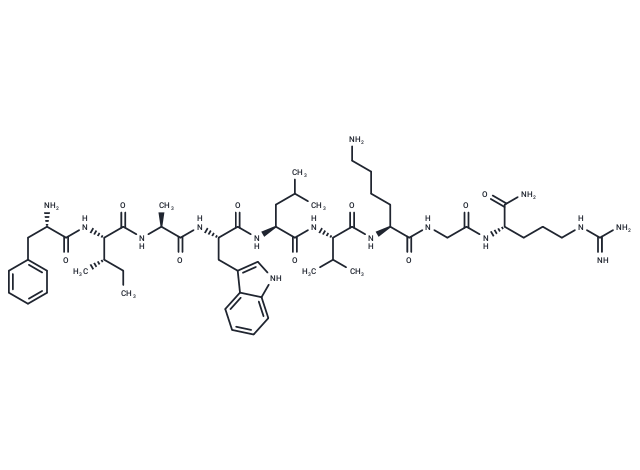Shopping Cart
Remove All Your shopping cart is currently empty
Your shopping cart is currently empty
GLP-1(28-36)amide, a C-terminal nonapeptide derived from the cleavage of GLP-1 by neutral endopeptidase (NEP), is an important compound that functions as an antioxidant primarily targeting the mitochondrion to inhibit mitochondrial permeability transition (MPT), displaying anti-diabetic properties and cardioprotection effects[1].

| Pack Size | Price | USA Warehouse | Global Warehouse | Quantity |
|---|---|---|---|---|
| 5 mg | $237 | Inquiry | Inquiry | |
| 10 mg | $397 | Inquiry | Inquiry |
| Description | GLP-1(28-36)amide, a C-terminal nonapeptide derived from the cleavage of GLP-1 by neutral endopeptidase (NEP), is an important compound that functions as an antioxidant primarily targeting the mitochondrion to inhibit mitochondrial permeability transition (MPT), displaying anti-diabetic properties and cardioprotection effects[1]. |
| In vitro | Unlike DPP-IV, the enzyme NEP cleaves GLP-1(7-36)amide or GLP-1(9-36)amide into GLP-1(28-36)amide and is prevalent in endothelial, vascular smooth muscle, cardiac, and renal epithelial cells[1]. Treatment with GLP-1(28-36)amide (100 nM) on hepatocytes for 24 hours specifically influences mitochondrial oxidative metabolism, including gluconeogenesis within hepatocyte mitochondria[1]. Moreover, the plasma half-life of GLP-1(28-36)amide in human hepatocytes (t1/2 = 24 min) surpasses its duration in mouse hepatocytes (t1/2 = 13 min)[1]. |
| In vivo | Administering GLP-1(28-36)amide at 18.5 nmol/kg body weight/day for 9 weeks significantly reduces hepatic steatosis in diet-induced obese mice. Similarly, daily intraperitoneal injections of 18 nmol/kg GLP-1(28-36)amide over 9 weeks enhance pancreatic β cell mass and proliferation, showcasing a cytoprotective effect in a β-cell injury diabetic mouse model. An in vivo study further reveals that a six-week course of GLP-1(28-36)amide at 18.5 nmol/kg in high-fat diet-fed mice significantly improves hepatic glucose metabolism, an effect linked with increased cAMP levels and PKA target phosphorylation. Moreover, a brief 20-minute administration of GLP-1(28-36)amide to male C57BL6/J mice followed by a procedure involving 30 minutes of global ischemia and 40 minutes of reperfusion results in a significantly enhanced recovery of left ventricular developed pressure (LVDP) in GLP-1(28-36)amide treated hearts compared to controls[1]. |
| Molecular Weight | 1088.37 |
| Formula | C54H85N15O9 |
| Cas No. | 1225021-13-5 |
| Smiles | CC[C@H](C)[C@H](NC(=O)[C@@H](N)Cc1ccccc1)C(=O)N[C@@H](C)C(=O)N[C@@H](Cc1c[nH]c2ccccc12)C(=O)N[C@@H](CC(C)C)C(=O)N[C@@H](C(C)C)C(=O)N[C@@H](CCCCN)C(=O)NCC(=O)N[C@@H](CCCNC(N)=N)C(N)=O |
| Sequence | Phe-Ile-Ala-Trp-Leu-Val-Lys-Gly-Arg-NH2 |
| Sequence Short | FIAWLVKGR-NH2 |
| Storage | keep away from moisture | Powder: -20°C for 3 years | In solvent: -80°C for 1 year | Shipping with blue ice/Shipping at ambient temperature. |
| Size | Quantity | Unit Price | Amount | Operation |
|---|

Copyright © 2015-2026 TargetMol Chemicals Inc. All Rights Reserved.